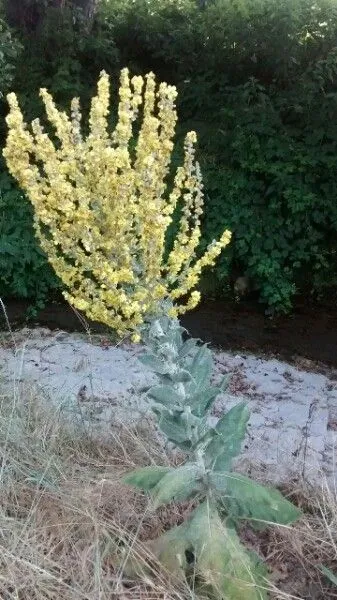
Author: Vill.
Bibliography: Prosp. Hist. Pl. Dauphiné: 22 (1779)
Year: 1779
Status: accepted
Rank: species
Genus: Verbascum
Vegetable: False
Observations: Europe
Broad-leaf mullein, scientifically known as Verbascum pulverulentum, is a remarkable plant that belongs to the Scrophulariaceae family. Characterized by its broad leaves, this species is native to various regions of Europe, where it thrives in a diverse range of environments.
The plant was first described in 1779, with its initial classification appearing in the “Prosp. Hist. Pl. Dauphiné: 22,” a significant botanical work authored by the distinguished botanist Vill. His detailed documentation laid the groundwork for subsequent studies and understanding of this species.
Broad-leaf mullein is noted for its substantial foliage, which serves as a distinguishing feature among its relatives within the Verbascum genus. The leaves are typically covered in a dense, woolly indumentum that gives them a silvery appearance and a soft texture. This characteristic not only aids in identifying the plant but also provides it with a measure of protection against herbivores and harsh weather conditions.
In terms of habitat, Verbascum pulverulentum favors sunny, open areas where the soil is well-drained. It is commonly found in meadows, grasslands, and along roadside verges, contributing to the biodiversity and ecological dynamics of these habitats. The plant often grows in clusters, forming dense patches that can dominate the landscape, particularly during its blooming season.
The flowers of the broad-leaf mullein are another striking feature. Arranged on tall spikes, they typically exhibit a bright yellow hue, which attracts a variety of pollinators, including bees and butterflies. This interaction not only supports the life cycle of the plant but also plays a crucial role in the maintenance of local ecosystems.
Given its adaptability and hardy nature, broad-leaf mullein has become a subject of interest for both botanists and horticulturists. Its ability to grow in less-than-ideal conditions makes it a valuable plant for study in resilience and environmental adaptability. Furthermore, its aesthetic appeal and ecological benefits underscore its importance within natural and cultivated landscapes alike.
In essence, Verbascum pulverulentum stands out not only for its botanical significance but also for its role in sustaining the environments where it is found. This multifaceted plant continues to be a focal point of research and admiration within the botanical community, ensuring its place in the annals of plant history.
Eng: broad-leaf mullein, hoary mullein
Deu: flocken-königskerze, flockige königskerze
Nld: vlokkige toorts
Swe: kandelaberkungsljus
Cym: pannog blawrwyn, pannog lwyd
En: Broad-leaf mullein, Hoary Mullein
Ca: Trepó pulverulent
Co: Arba catalina
Nl: Vlokkige toorts
Fr: Molène floconneuse, Molène pulvérulente
De: Flockige Königskerze, Flocken-Königskerze, Flockiges Wollkraut
It: Verbasco a candelabro
Es: Gordolobo, Verbasco
Sv: Kandelaberkungsljus
Cy: Pannog lwyd, Pannog Blawrwyn
Taken Jun 10, 2018 by Silvia Dornauer – Kiszler (cc-by-sa)
Taken Jun 11, 2018 by Creu Lopez (cc-by-sa)
Taken Jun 13, 2018 by Fejul Xeto (cc-by-sa)
Taken Jun 13, 2018 by Fejul Xeto (cc-by-sa)
Taken Jun 13, 2018 by Fejul Xeto (cc-by-sa)
Taken Jun 11, 2018 by Creu Lopez (cc-by-sa)
Taken Jun 13, 2018 by Fejul Xeto (cc-by-sa)
Taken Jun 21, 2018 by Pep Secem (cc-by-sa)
Taken Jun 16, 2017 by 1 (cc-by-sa)
Taken Jun 11, 2018 by Creu Lopez (cc-by-sa)
Taken Jun 13, 2018 by jose (cc-by-sa)
Taken Jun 11, 2018 by Creu Lopez (cc-by-sa)
Taken Jun 13, 2018 by Fejul Xeto (cc-by-sa)
Taken Jun 11, 2018 by Creu Lopez (cc-by-sa)
Taken Jun 11, 2018 by Creu Lopez (cc-by-sa)
Taken Jun 21, 2017 by Yoan MARTIN (cc-by-sa)
Taken Aug 21, 2016 by Tela Botanica − Dominique REMAUD (cc-by-sa)
Taken Jun 13, 2018 by jose (cc-by-sa)
Taken Jun 11, 2018 by Creu Lopez (cc-by-sa)
Taken Jun 13, 2018 by Fejul Xeto (cc-by-sa)
Taken Jul 10, 2019 by Aurélie giraud (cc-by-sa)
Taken Aug 14, 2021 by Valdis Hliddal (cc-by-sa)
Taken May 29, 2022 by JC Paniagua (cc-by-sa)
Taken Jul 4, 2014 by Tela Botanica − Jean-Claude ECHARDOUR (cc-by-sa)
Taken Apr 25, 2021 by Alain Bigou (cc-by-sa)
Taken Jul 22, 2018 by Kilian Jungkeit (cc-by-sa)
Taken May 2, 2021 by Fabienne LASPESA (cc-by-sa)
Taken Jan 1, 1800 by Tela Botanica − Thierry Pernot (cc-by-sa)
Taken Dec 30, 2020 by Ros Pedro (cc-by-sa)
Taken Aug 17, 2021 by BeeCharmer (cc-by-sa)
© copyright of the Board of Trustees of the Royal Botanic Gardens, Kew.
© copyright of the Board of Trustees of the Royal Botanic Gardens, Kew.
© copyright of the Board of Trustees of the Royal Botanic Gardens, Kew.
Growth habit: Forb/herb
Ph maximum: 8.0
Ph minimum: 7.5
Light: 8
Atmospheric humidity: 5
Bloom months: [‘jun’, ‘jul’, ‘aug’, ‘sep’]
Soil nutriments: 6
Family: Myrtaceae Author: (F.Muell.) K.D.Hill & L.A.S.Johnson Bibliography: Telopea 6: 402 (1995) Year: 1995 Status:…
Family: Rubiaceae Author: Pierre ex A.Froehner Bibliography: Notizbl. Bot. Gart. Berlin-Dahlem 1: 237 (1897) Year:…
Family: Sapindaceae Author: Koidz. Bibliography: J. Coll. Sci. Imp. Univ. Tokyo 32(1): 38 (1911) Year:…
Family: Asteraceae Author: A.Gray Bibliography: Pacif. Railr. Rep.: 107 (1857) Year: 1857 Status: accepted Rank:…
Family: Fabaceae Author: Medik. Bibliography: Vorles. Churpfälz. Phys.-Ökon. Ges. 2: 398 (1787) Year: 1787 Status:…
Family: Aspleniaceae Author: (Cav.) Alston Bibliography: Bull. Misc. Inform. Kew 1932: 309 (1932) Year: 1932…